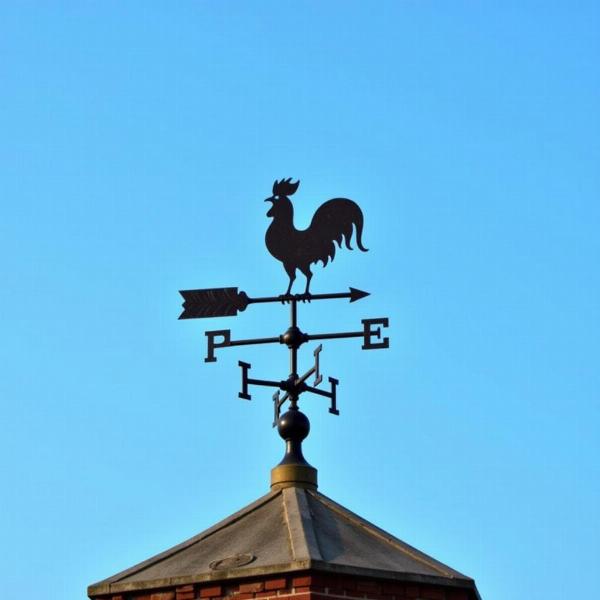Understanding the meaning and significance of a weathercock, especially within the Indian context, can be intriguing. While seemingly a simple wind direction indicator, the weathercock holds symbolic and cultural weight, often linked to religious and architectural traditions. This article will explore the “weathercock meaning in Hindi,” delving into its linguistic nuances, symbolic interpretations, and practical applications.
What Does Weathercock Mean in Hindi?
The Hindi word for weathercock is commonly मौसम फलक (mausam falak). मौसम (mausam) means weather, and फलक (falak) refers to a board or a surface, often implying a directional indicator. Sometimes, you might also encounter the term हवा का झंडा (hava ka jhanda), which translates to “wind flag,” a more descriptive term reflecting its function. While both terms point to the same object, मौसम फलक (mausam falak) is generally preferred for its conciseness and accuracy. Understanding these terms provides a foundation for exploring the deeper cultural implications of the weathercock in India.
 Weathercock on Rooftop
Weathercock on Rooftop
The Symbolism of the Weathercock
Beyond its practical use, the weathercock carries symbolic weight across various cultures. In some traditions, it represents vigilance and foresight, always alert to the changing winds of fortune. It can also symbolize adaptability and resilience, adjusting to external forces while remaining firmly grounded. In Christian symbolism, the rooster-shaped weathercock often adorns church steeples, reminding worshippers of Peter’s denial of Christ and serving as a call to spiritual vigilance. This symbolism, though originating in Western religious contexts, can also resonate within India’s diverse religious landscape, where themes of vigilance and adaptability hold significance.
Weathercocks in Indian Architecture
While not as ubiquitous as in some Western countries, weathercocks do feature in certain architectural styles within India, particularly in older buildings influenced by colonial architecture. They might be seen on churches, government buildings, and occasionally, grand residences. Their presence often adds a touch of historical charm and visual interest to the structures.
How Does a Weathercock Work?
The mechanism of a weathercock is deceptively simple. It consists of a freely rotating vane, usually adorned with a decorative figure, mounted on a fixed vertical rod. The vane is designed to catch the wind, causing it to rotate and point in the direction from which the wind is blowing. The tail of the vane, being larger or shaped differently than the head, offers greater wind resistance, ensuring that the pointer consistently faces into the wind.
Weathercock vs. Wind Vane: Is There a Difference?
While often used interchangeably, “weathercock” and “wind vane” have subtle distinctions. “Wind vane” is a broader term encompassing any device used to measure wind direction. “Weathercock,” on the other hand, specifically refers to a wind vane adorned with a rooster figure. This distinction, however, is not always strictly observed in common usage.
What is the Importance of a Weathercock?
Historically, weathercocks served a vital purpose in predicting weather patterns, particularly crucial for agriculture and navigation. In modern times, with advanced meteorological tools, their practical use has diminished. However, they continue to hold cultural and aesthetic value, adding a touch of tradition and charm to buildings.
Conclusion
From its Hindi meanings – मौसम फलक (mausam falak) and हवा का झंडा (hava ka jhanda) – to its symbolic interpretations and practical applications, the weathercock represents a fascinating intersection of language, culture, and technology. While its role in meteorology has lessened, its symbolic presence continues to enrich our understanding of architectural traditions and cultural expressions.
FAQs
- What is the literal translation of “weathercock” in Hindi? The most common translation is मौसम फलक (mausam falak), meaning “weather board” or “weather indicator.”
- Are weathercocks commonly used in India today? While not as prevalent as in the past, they can still be found on older buildings, adding a touch of historical character.
- What is the symbolic significance of a rooster-shaped weathercock? It often represents vigilance, foresight, and a reminder of spiritual awareness.
- How does a weathercock work? The wind catches the vane, causing it to rotate and point in the direction from which the wind is blowing.
- What is the difference between a weathercock and a wind vane? “Weathercock” specifically refers to a rooster-shaped wind vane, while “wind vane” is a broader term.
Recommended Articles (If any relevant articles exist on Meaning-Hindi.in, please link them here).
Meaning-Hindi.in is your trusted partner for high-quality Hindi translation services. We specialize in various translation domains, including business and commercial documents, legal and certified translations, technical manuals, website localization, educational and academic materials, and express translation services. Our expert linguists ensure accurate and culturally sensitive translations, bridging language barriers effectively. For all your Hindi translation needs, contact us at [email protected] or call us at +91 11-4502-7584. Let Meaning-Hindi.in be your gateway to seamless communication.